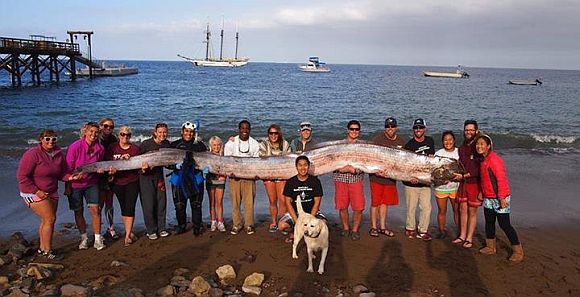 Last week, two rare oarfish washed up (or in the case of the first was dragged up) on the shores of Southern California. Yesterday, Japan was stuck by a 7.3 magnitude earthquake. A coincidence? It seems that there is Japanese folklore that says that sighting of oarfish portends a coming earthquake. Oarfish are the longest bony fish in the ocean and can grow up to around 17 meters or 56 feet long. The two that washed up in California were only 18′ and 14′ long, which is still very impressive. Oarfish, which tend to stay in deep water, are rarely seen on the surface. When they do make an appearance they are understandably often referred to as “sea serpents,” given their long snake-like bodies. It is easy to understand how they might be useful in folklore as a predictor of ill-tidings. If sea serpents start appearing, something bad must be coming. In Japan, the oarfish is traditionally known as the “Messenger from the Sea God’s Palace.” (If the Sea God is sending you a message, it is better sent by a sea serpent rather than a sea bass.)
Last week, two rare oarfish washed up (or in the case of the first was dragged up) on the shores of Southern California. Yesterday, Japan was stuck by a 7.3 magnitude earthquake. A coincidence? It seems that there is Japanese folklore that says that sighting of oarfish portends a coming earthquake. Oarfish are the longest bony fish in the ocean and can grow up to around 17 meters or 56 feet long. The two that washed up in California were only 18′ and 14′ long, which is still very impressive. Oarfish, which tend to stay in deep water, are rarely seen on the surface. When they do make an appearance they are understandably often referred to as “sea serpents,” given their long snake-like bodies. It is easy to understand how they might be useful in folklore as a predictor of ill-tidings. If sea serpents start appearing, something bad must be coming. In Japan, the oarfish is traditionally known as the “Messenger from the Sea God’s Palace.” (If the Sea God is sending you a message, it is better sent by a sea serpent rather than a sea bass.)
But does the appearance of oarfish really predict an earthquake? Several news sources seem to suggest the possibility. The NBC Science blog proclaims, “Can oarfish predict earthquakes? Maybe it’s not as crazy as it sounds.” They note that, “some are claiming that oarfish washing ashore is a sign that an earthquake will soon follow. Shortly before the 2011 Tohoku earthquake and tsunami struck Japan, about 20 oarfish stranded themselves on beaches in the area, Mark Benfield, a researcher at Louisiana State University, told LiveScience in an earlier interview.”
The problem here is the use of the word “shortly.” The twenty oar fish, many of which were not “stranded” but caught in nets, showed up one year and one month prior to the Japanese Tohuku earthquake. Thirteen months doesn’t sound like it was “shortly before” the earthquake.
Others point out that a quake in Chile occurred shortly after the 2010 sightings of the oarfish off Japan. (By shortly, I mean a few weeks, not thirteen months.) The problem here is one of geography. Japan and Chile are both on the Pacific Ocean, but they are in different hemispheres and over 9,000 nautical miles apart. Could Japanese oarfish sense seismic activity on the side of the Pacific? And if so, what were the Chilean oarfish doing at the time? Oarfish are found in all oceans around the world.
Likewise, the oarfish that recently came ashore off California were around 4,000 nautical miles from yesterday’s Japanese earthquake. What were the Japanese oarfish up to?
One thing that becomes immediately obvious is that there are many more earthquakes than there are oafish sightings. If oarfish do predict quakes they are doing a really bad job at it. Or, as Dr. Craig McClain, of DeepSeaNews, tweeted:


“Brownie” Oarfish, “You’re doing a heck of a job!”
We haven’t had a single earthquake since “Brownie” has been standing at the ready, waiting to warn landlubbers of pending doom from any surprise shakers.